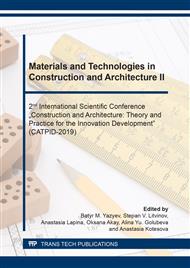[1]
Yu.V. Khomchenko, V.D. Barbanyagre, Intensification of production and improving the quality of extruded autoclaved materials based on the binder wet grinding, Bulletin of BSTU named after V.G. Shukhov. 2 (2008) 7-10.
Google Scholar
[2]
A.N. Volodchenko, Alumosilicate raw material for receiving autoclaid finishing materials, Bulletin of BSTU named after V.G. Shukhov. 2 (2017) 172-177.
Google Scholar
[3]
N.I. Alfimova, N.N. Shapovalov, O.S. Abrosimova, Operational characteristics of silicate brick, manufactured by using technological alyumosilicate raw materials, Bulletin of BSTU named after V.G. Shukhov. 3 (2013) 11-14.
Google Scholar
[4]
A. Stepien, P. Kostrzewa The impact of glass components on the quality and strength of silicate autoclaved materials, IOP Conf. Ser.: Mater. Sci. Eng. 471 (2019) 032064.
DOI: 10.1088/1757-899x/471/3/032064
Google Scholar
[5]
A.Yu. Semeykin, Yu.V. Khomchenko, The monitoring and audition system of working condition and labor protection in Belgorod region, Technology of technosphere safety. 5(45) (2012).
Google Scholar
[6]
K.S. Creely, H. Cowie, M. Van Tongeren, H. Kromhout, J. Tickner, J. W. Cherrie, Trends in inhalation exposure – A review of the data in the published scientific literature, Annals of Occupational Hygiene. 51 (8) (2007) 665-678.
Google Scholar
[7]
R. Iler, Chemistry of silica, A Wiley-Interscience Publication, (1979).
Google Scholar
[8]
P.E.J. Baldwin, T. Yates, H. Beattie, C. Keen, N. Warren, Exposure to respirable crystalline silica in the Gb brick manufacturing and stone working industries, Annals of Work Exposures and Health. 63 (2) (2019) 184-196.
DOI: 10.1093/annweh/wxy103
Google Scholar
[9]
M. Sahri, A.R. Tualeka, N. Widajati, Quantitative risk assesment of crystalline silica exposure in ceramics industry, Indian Journal of Public Health Research and Development. 10(2) (2019) 601-604.
DOI: 10.5958/0976-5506.2019.00358.9
Google Scholar
[10]
F. Liu, Y. Han, L. Du, P. Huang, J. Zhe, Airborne mineral dust measurement using an integrated microfluidic device, Microfluidics and Nanofluidics. 20 (1) (2016) 27.
DOI: 10.1007/s10404-015-1672-3
Google Scholar
[11]
A. Peters, H. E. Wichmann, T. Tuch, J. Heinrich, J. Heyder, Respiratory effects are associated with the number of ultrafine particles, American Journal of Respiratory and Critical Care Medicine, 155 (4) (1997) 1376-1383.
DOI: 10.1164/ajrccm.155.4.9105082
Google Scholar
[12]
M. A. Stefanidou, Role of water-binder ratio on the porosity in lime-based mortars, International Journal of Engeering Applications. 6(2) (2018).
Google Scholar
[13]
C. Mugford, J.L. Gibbs, R. Boylstein, Elemental properties of copper slag and measured airborne exposures at a copper slag processing facility, Journal of occupational and environmental hygiene. 14(8) (2017) 120-129.
DOI: 10.1080/15459624.2017.1316388
Google Scholar
[14]
X. Zhang, S. Guo, J. Liu, Z. Zhang, K. Song, C. Tan, H. Li, A study on the removal of copper (II) from aqueous solution using lime sand bricks, Applied Sciences. 9(670) (2019) 2-19.
DOI: 10.3390/app9040670
Google Scholar
[15]
S. Shaw, S.M. Clark, C.M.B. Henderson, Hydrothermal formation of the calcium silicate hydrates, tobermorite (Ca5Si6O16(OH)2·4H2O) and xonotlite Ca6Si6O17(OH)2: an in situ synchrotron study, Chemical Geology. 167 (2000) 129-140.
DOI: 10.1016/s0009-2541(99)00205-3
Google Scholar
[16]
T. Mitsuda, H.F.W. Taylor, Influence of aluminium on the conversion of calcium silicate hydrate gels into 11 A° tobermorite at 908°C and 1208°C. Cem. Concr. Res. 5 (1975) 203-210.
DOI: 10.1016/0008-8846(75)90001-0
Google Scholar
[17]
A. Stepien, B. Potrzeszcz-Sut, P. Kostrzewa, Influence and Application of Glass Cullet in Autoclaved Materials, IOP Conf. Ser.: Mater. Sci. Eng. 471 (2019) 032065.
DOI: 10.1088/1757-899x/471/3/032065
Google Scholar
[18]
Y. Feng, J. Kero, Q. Yang, Q. Chen, F. Engström, C. Samuelsson, C. Qi, Mechanical activation of granulated copper slag and its influence on hydration heat and compressive strength of blended cement, Materials. 12 (772) (2019) 2-19.
DOI: 10.3390/ma12050772
Google Scholar
[19]
C. Shi, C. Meyer, A. Behnood, Utilization of copper slag in cement and concrete, Resour. Conserv. Recycl. 52 (2008) 1115-1120.
DOI: 10.1016/j.resconrec.2008.06.008
Google Scholar
[20]
A. Shvarzman, K. Kovler, I. Schamban, G.S. Grader, G.E. Shter, Influence of chemical and phase composition of mineral admixtures on their pozzolanic activity, Adv. Cem. Res. 14 (2002) 35-41.
DOI: 10.1680/adcr.2002.14.1.35
Google Scholar
[21]
N.Yu. Kiryushina, A.Yu. Semeykin, Optimization of wastewater treatment from Cd2+ ions using slag of electric furnace steelmaking production, Solid State Phenomena. 284 (2018) 795-800.
DOI: 10.4028/www.scientific.net/ssp.284.795
Google Scholar
[22]
Pat. 2303013 Russian Federation, IPC C04B 28/20, C04B 111/20, Lime-silica binder, method of preparation of lime-silica binder and method of preparation of silicate mixture based on lime-silica binder for pressed products of autoclave hardening.
DOI: 10.31659/0585-430x-2019-773-8-14-17
Google Scholar
[23]
Pat. 2305666 Russian Federation, IPC C04B 28/20, C04B 111/20, Lime binder, method of lime preparation binder and preparation method of silicate mixture based on lime binder for extruded products, autoclaved products.
Google Scholar


